September 3-October 18, 2009
![Plate VI [Jupiter Terrace], 12th Annual Report of the U. S. Geological and Geographic Survey of the Northwest Territories by F. V. Hayden, 1878", from the series Views from Wonderland by Janet L. Pritchard © 2008](https://benton.media.uconn.edu/wp-content/uploads/sites/2454/2014/06/Pritchard.jpg)
September 3-October 18, 2009
![Plate VI [Jupiter Terrace], 12th Annual Report of the U. S. Geological and Geographic Survey of the Northwest Territories by F. V. Hayden, 1878", from the series Views from Wonderland by Janet L. Pritchard © 2008](https://benton.media.uconn.edu/wp-content/uploads/sites/2454/2014/06/Pritchard.jpg)
June 6 – August 9, 2009
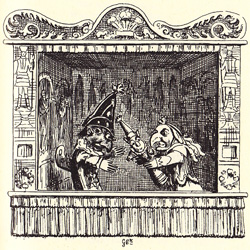
Punch and Judy have come to symbolize the world of puppet theater for many audiences on both sides of the Atlantic. Known for their comic antics and Punch’s ever-present club, these puppets at first glance might appear to be benign and colorful entertainment for children. But a closer look at these twocharacters and their puppet brethren reveals a complex andoften contradictory world of comedy, mayhem, sex, violence, and politics.
Punch & Judy: Handpuppets, Politics & Humor explores the world of these classic characters and related realms of handpuppets and satire. It includes Punch and Judy handpuppet sets as well as Guignol and Kasperl puppets from France and Germany, and the Punch and Judy set used by the famed creator of queer theater, Charles Ludlam. In addition, there are handpuppets created by Rufus Rose to satirize Connecticut politicians, which Rose created while he was a Republican State Legislator and which he performed in the Connecticut State House.
This exhibition was curated by Ballard Institute and Museum of Puppetry director John Bell, with graduate assistants Stefano Brancato and Joseph Therrien.
June 6 – August 9, 2009
A Touch of Humor explores the complex nature of humor. What amuses us? What roles do age, geography, cultural upbringing and personal experiences play in appreciating humor? While the exhibition includes works from the 19th century, it is the 20th century, particularly in American art, that encompasses a broad range of humorous expression. Adolf Dehn (1895-1968) is represented by several works, including his well-known satire of the scandalous 1912 painting September Morn. John Sloan’sReducing (1916) parodies the intentions of a young woman who exercises while her husband lies sleeping in bed. Norman Rockwell’s 1958 painting of a jockey Weighing In is featured. It and several other works were loaned to the Benton by the New Britain Museum of American Art.
It is hoped that A Touch of Humor will lift people’s spirits during these times and confirm that laughter is, indeed, the best medicine.
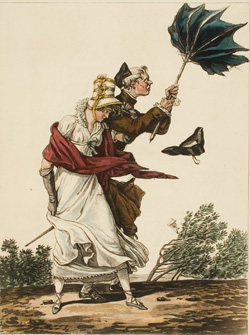
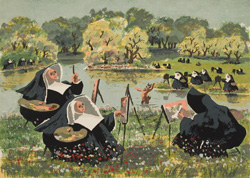
April 4 – May 10, 2009
The William Benton Museum of Art at the University of Connecticut is pleased to present the works of the 2009 Master of Fine Arts degree candidates in an exhibition entitled apperceptions. The public is invited to meet the artists at a reception in their honor on Friday, April 3, 5-7:30 pm. The exhibition is on view April 4 through May 10.
Michael Donovan, a sculptor and printmaker, was born in Bridgeport, and currently resides in Naugatuck, Connecticut. In 2005 he received his Bachelor of Science degree in studio art with an emphasis in sculpture from Southern Connecticut State University where he received the Third Annual Olafs Zeidenbergs Award. Donovan’s work was included in “The Lasso Project” at Art Space in New Haven in 2007 and has appeared in several exhibitions in the New Haven and Storrs area.
Artist Statement: I create sculptural implements fixed in mid-function as absurd monuments. Using wood and steel, my work embodies both the structure and utility of a tool as it acts upon itself. The physical task that each piece performs creates tension and potential energy within the work that is never released. Each piece performs a designated task with no true purpose other than sustaining the level of energy generated within it. Interacting within each piece structural elements become dependent on one another, maintaining a senseless state of permanence. By perpetually engaging tool with task my sculptural objects become self- contained events.
March 17 – May 10, 2009
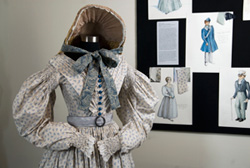 In England, they call Judy Heywood’s job “Costume Interpretation,” a term that aptly describes what she has done for the Connecticut Repertory Theatre for more than twenty years. She has taken two-dimensional drawings by MFA Costume Design students and turned them into three-dimensional sculptures, filling the gaps between reality and renderings, helping to choose the correct fabric to achieve the right drape, and creating the most appropriate style lines for the period and the performer’s physique while respecting the role each costume plays in a production.
In England, they call Judy Heywood’s job “Costume Interpretation,” a term that aptly describes what she has done for the Connecticut Repertory Theatre for more than twenty years. She has taken two-dimensional drawings by MFA Costume Design students and turned them into three-dimensional sculptures, filling the gaps between reality and renderings, helping to choose the correct fabric to achieve the right drape, and creating the most appropriate style lines for the period and the performer’s physique while respecting the role each costume plays in a production.
March 17 – May 10, 2009
The Benton’s contribution to the University-wide “Year of Science 2009” celebration is an exhibition that chronicles the history of medical illustration through a selection of prints, drawings, computer graphics and animation from the 16th century to the present. Each piece articulates a unique union of art, anatomy and medicine, the works together reflecting the ways that union has evolved over the centuries and continues to thrive in an era of digital photography and 3-D imaging.
The works in Anatomically Correct come out of a pictorial tradition that was set in motion by the Belgian anatomist Andreas Vesalius (1514–1564). He conducted his dissections firsthand, breaking away from the longstanding authority of classical texts by relying on direct observation. He similarly reformed scientific illustration by insisting upon anatomical accuracy and precision for the plates in his pivotal work, De Humani Corporis Fabrica (On the Fabric of the Human Body) of 1543. These illustrations by the artist John Van Calcar divided the field of scientific illustration into “pre-Vesalian” and “post-Vesalian” periods. With Vesalius’s brilliant integration of image and text, illustration began to serve a crucial function in the communication of scientific information, initiating the role of scientific illustration as a record of the progress of science in general.
Along with Vesalius’s contributions, Anatomically Correct highlights significant post-Vesalian developments that carried his vision into the present. Illustrations from William Hunter’s The Anatomy of the Human Gravid Uterus (1774) played a vital role in establishing obstetrics as a field of medicine rather than a practice of midwives. A major advancement in print technology is represented by color lithography in Jean Marc Bourgery’s Atlas of Anatomy (1831–1854). A shift in the role of illustration from works of art in themselves to didactic tools can be seen in Henry Gray’s Anatomy: Descriptive and Surgical (1858), and the increased role of the computer in contemporary illustration is evidenced in the 3-D animation of the Connecticut-based XVIVO studio.
In a discipline we associate with objectivity and empiricism, the works in the exhibition consistently reveal themselves to be products of their respective social climates. Ideological and social conventions inevitably come through in the illustrations as anatomists and artist catered to their audience’s desire to see the body represented morally, socially, theologically.
Anatomically Correct commemorates the 200th anniversary of Charles Darwin’s birth. The exhibition is particularly relevant to this moment of celebration as a reflection on the advancement in the field of anatomy as a basis for the theory of evolution and as an acknowledgement of the role of art as critical to the way these advancements were visualized.
Exhibition curated by Eve Perry, M.A. candidate, Art History, 2009.
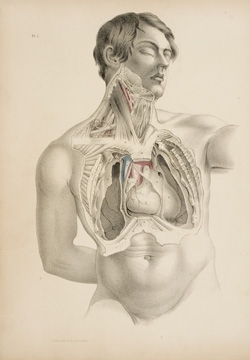
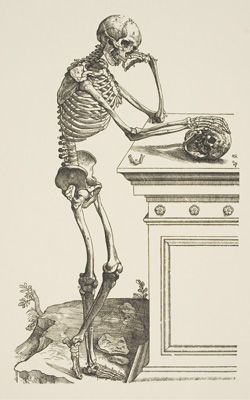
January 20–March 6, 2009
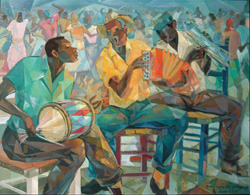
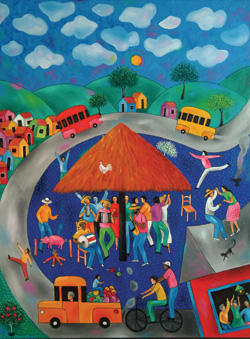
¡Merengue! Visual Rhythms is the first exhibition to explore the historical role merengue has played as a fundamental cultural axis, a form of communication and a symbol in the visual arts of the Dominican Republic.
These forty works include paintings, works on paper, photographs, sculpture, video, and popular graphics that span the 20th century and examine the evolving artistic styles practiced by Dominican artists to celebrate the island’s most important musical and dance form.
Tracing the tradition of merengue and its intersections with the visual arts, this exhibition translates the energy and festivity of the beloved national music through depictions of both traditional rural celebrations and more contemporary scenes. Ultimately, merengue is seen as a central element in the life and culture of the island. An illustrated timeline relates the featured art to important events in Dominican history.
This exhibition was organized by Centro Cultural Eduardo León Jimenes in Santiago, Dominican Republic, curated by Sara Hermann, and organized for tour by International Arts & Artists, Washington, D.C.
January 20 – March 6, 2009

Yuyanapaq: To Remember is a witness, in words and images, to the extreme political violence that consumed the Peruvian nation between 1980 and 2000. These two decades saw an outbreak of violence that involved insurgents, state armed forces, paramilitary groups, and peasants’ self-defense organizations. It was instigated by the Maoist organization, known as “Shining Path,” and justified as a revolutionary uprising against the Peruvian state. While Shining Path rejected, in general, the idea of human rights as “bourgeois, reactionary, counterrevolutionary rights, [which] are today a weapon of revisionists and imperialists, principally Yankee imperialists,” the government likewise committed human rights violations, although fewer in number and on a lesser scale. In 2003 the Peruvian Truth and Reconciliation Commission issued a report that estimated that 69,280 Peruvians lost their lives during this period. As part of the Truth Commission’s effort to document the history of this period and depict the ways in which violence impacted on Peruvians’ daily lives, an exhibition of 250 photographs was created from more than 90 archives belonging to different media outlets, news agencies, military institutions, human right organizations, and private collections. A traveling exhibition of 40 photographs was organized in 2004 and has been shown in Mexico, Italy, Spain, and Switzerland.
January 20 – March 6, 2009
This exhibition of works from the Museum’s collection highlights music in the visual arts as both imagery and an influence on design.